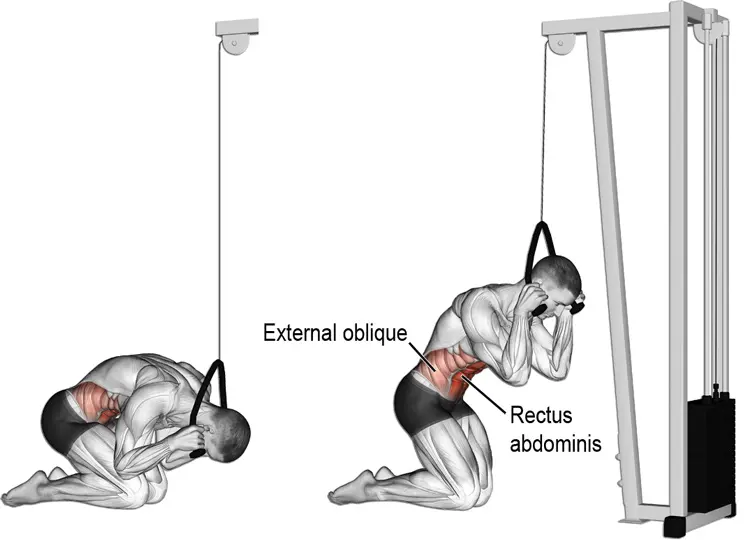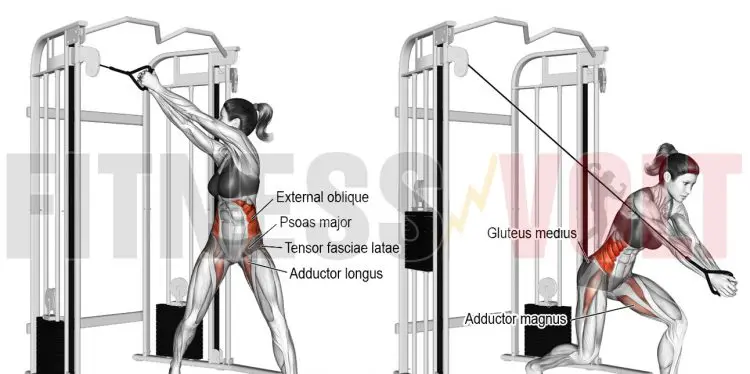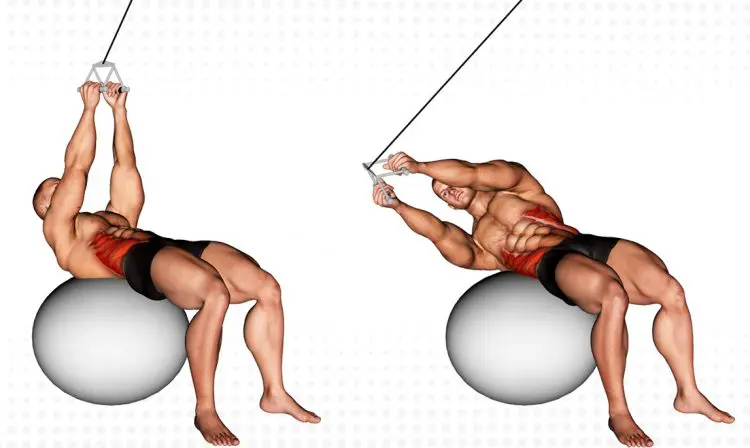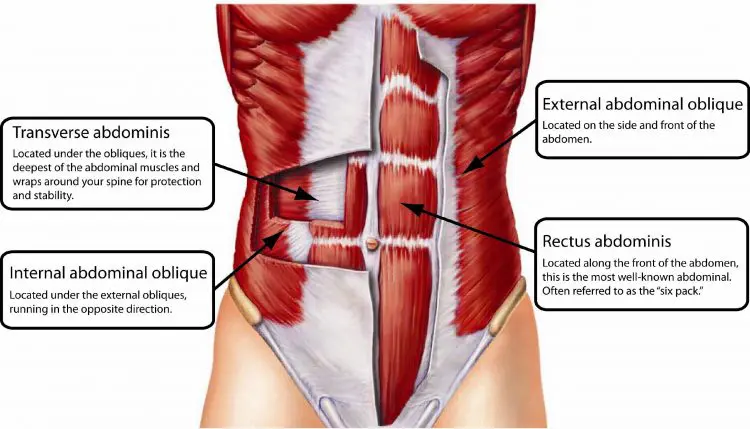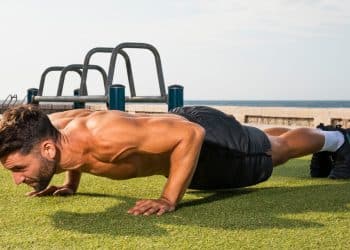When it comes to core and abs training, most people automatically gravitate toward bodyweight exercises. The reason for this is that bodyweight exercises are simple. Just lay down on the nearest exercise mat and start cranking out the crunches!
While those bodyweight abs exercises are undeniably convenient, they also have drawbacks. The main one is that, for all but the most deconditioned beginners, many are too easy to have much of an effect.
Yes, there are super-tough abs exercises you can do, like human flags, for example, but those aren’t the ones I’m talking about here.
Instead, I’m referring to exercises like crunches, sit-ups, planks, side planks, and leg raises. These don’t provide much of a challenge for intermediate and advanced exercisers.
That’s why you’ll see most people pumping out dozens, if not hundreds of reps or holding a plank for minutes at a time. Not only is this an inefficient use of your time, but it’s also an ineffective way to train your muscles. After all, you wouldn’t do sets of 50 reps of biceps curls to increase arm size and strength.
If you want to develop the abs of your dreams, you must overload your muscles, and one of the best ways to do that is with the best cable exercises for abs.
Level Up Your Fitness: Join our 💪 strong community in Fitness Volt Newsletter. Get daily inspiration, expert-backed workouts, nutrition tips, the latest in strength sports, and the support you need to reach your goals. Subscribe for free!
As a personal trainer with over 35 years of hands-on experience, I’ve helped numerous people build a shredded six-pack with nothing more than a cable pulley machine. In this article, I reveal the 15 most effective exercises you can do to sculpt your midsection.
Recent Updates: On July 16, 2024, Fitness Volt’s Contributing Editor Andrew Peloquin (NFPT-CPT) and Senior Editor Vidur Saini (American Council on Exercise-CPT) updated the article and added actionable expert tips throughout the piece to improve the reader experience.
Top 15 Cable Exercises for Abs
To avoid injury and maximize your performance, warm up before doing any of the following cable exercises. A few minutes of light cardio, followed by some dynamic joint mobility and flexibility exercises, should suffice. Alternatively, you can do your abs exercises at the end of your workout, when you should be warm enough already.
- Kneeling Cable Crunch
- Pallof Press
- Cable Side Bend
- Vertical Pallof Press
- Standing Cable Row
- Cable Woodchop
- Cable Twists
- Twisting Cable Overhead Press
- Cable Russian Twists with a Stability Ball
- Reverse Cable Crunches
- Cable Side Crunch
- Single Arm Cable Chest Press
- Plank Cable Row
- Side Plank Cable Row
- Double Cable Crunch or Cable Tuck Crunch
1. Kneeling Cable Crunch
| Sets & Reps | Equipment Needed | Target Muscles |
| 3 x 10-15 | High-Pulley Cable | Rectus abdominis, obliques |
If you want to overload your rectus abdominus muscle, this is the exercise to do it. It allows you to work your abs hard and heavy, making it a useful alternative to regular crunches on the floor.
As an added advantage, kneeling cable crunches allow you to work your abs through a long range of motion, from stretched to fully contracted. This is another reason that kneeling cable crunches are superior to floor crunches.
“This is a fantastic starting exercise for targeting the rectus abdominis, especially for those new to cable machines,” says Saini. It allows for a controlled range of motion and a focused contraction.
Pro Tip: During the concentric phase, focus on exhaling forcefully as you contract the abdominals, initiating the movement from the ribcage rather than the hips.
| Difficulty | Progression | Regression |
| Beginner | Increase reps, add resistance, perform standing cable crunches | Conventional crunches |
2. Pallof Press
| Sets & Reps | Equipment Needed | Target Muscles |
| 3 x 10-12/side | Cable Machine | Transverse abdominis, obliques, core |
This cable abs exercise works your entire core. You’ll need to brace your midsection to keep your torso rigid as you extend your arms out in front of you. Think of this one as an anti-movement exercise as you’ll be using your core muscles to maintain posture and stability.
This is an isometric exercise, which means your muscles generate force, but there is no joint movement. This is how your core often has to work in nature.
Pallof presses can be done standing, kneeling, and in the half-kneeling position for variety.
“This exercise is a game-changer for core stability,” adds Saini. It activates deep core muscles that are essential for injury prevention and performance enhancement.
Pro Tip: Maintain a neutral spine throughout the movement, resisting the rotational pull of the cable. Imagine pushing your belly button towards your spine to engage your deep core muscles.
| Difficulty | Progression | Regression |
| Intermediate | Try the single-arm variation | Perform kneeling |
3. Cable Side Bend
| Sets & Reps | Equipment Needed | Target Muscles |
| 3 x 12-15/side | Cable Machine | Obliques |
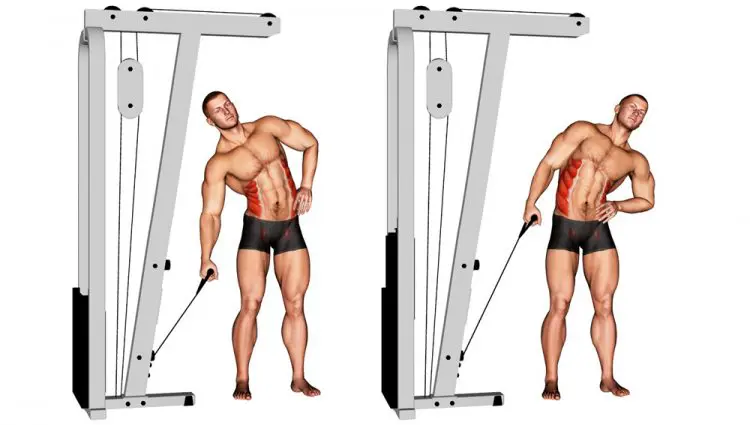
Side bends are often done using dumbbells. While this works fine, a low cable machine may be better because it keeps your muscles under constant tension, which usually produces better muscle-building results. Also, a lot of people mistakenly hold a dumbbell in each hand. This creates a seesaw effect as one weight counterbalances the other. You can’t make this mistake with cable side bends.
Saini recommends this exercise for shaping your obliques and cinching your waist as it keeps constant tension on the target muscles.
Pro Tip: Don’t rush this exercise. Instead, perform it slowly and with control, feeling the stretch and contraction in your obliques on each rep.
| Difficulty | Progression | Regression |
| Beginner | Tempo reps | Bodyweight side bends |
4. Vertical Pallof Press
| Sets & Reps | Equipment Needed | Target Muscles |
| 3 x 10-12 | Cable Machine | Transverse abdominis, obliques, core |
This version of Pallof presses involves pushing your arms overhead instead of out in front of you. This creates a longer lever and, therefore, a more demanding workout. It’s still an anti-movement isometric exercise, but the different angle of pull means it feels quite different from the standard horizontal Pallof press.
Saini explains that this anti-rotation exercise is a must-have for athletes. It challenges your core to resist rotational forces, improving your athletic performance and reducing the risk of injury.
Pro Tip: Initiate the press by bracing your core and protracting your shoulder blades. This will help prevent your shoulders from rounding forward and ensure proper muscle activation.
| Difficulty | Progression | Regression |
| Intermediate | Half-kneeling position | Perform on both knees |
5. Standing Cable Row
| Sets & Reps | Equipment Needed | Target Muscles |
| 3 x 8-12 | Low-Pulley Cable | Rectus abdominis, obliques |
Many cable exercises for abs involve other muscles, too. For example, this standing cable row also works your lats, biceps, and legs, making it a total-body exercise.
While this isn’t always the best way to build muscle, it’s an excellent way to train your midsection because, more often than not, this is how your core works in nature – in conjunction with the rest of your body. Subsequently, this is a VERY functional cable abs exercise.
Saini suggests this exercise is a powerhouse for building a strong, defined midsection. It works your rectus abdominis isometrically while engaging your back muscles for a full-body challenge.
Pro Tip: Think about pulling the cable handle towards your belly button rather than just your chest for optimal midline activation.
| Difficulty | Progression | Regression |
| Beginner | Isometric holds at the top and bottom | Seated row |
6. Cable Woodchop
| Sets & Reps | Equipment Needed | Target Muscles |
| 3 x 10-12/side | High-Pulley Cable | Obliques, transverse abdominis, core |
Cable woodchops mainly work your obliques. As the name suggests, they replicate swinging an axe to cut wood. They can be done from high to low or low to high for variety. This does not change the muscles being worked, and the basic technique is the same. However, if you do a lot of cable woodchops, you may appreciate having two options available.
Cable woodchops target both your obliques and transverse abdominis, which are crucial for stability and functional strength, explains Saini.
Pro Tip: Maintain a soft bend in your elbows throughout the movement to prevent joint stress. Focus on rotating through your torso, initiating the movement from your core, not your arms.
| Difficulty | Progression | Regression |
| Intermediate | Perform kneeling | Russian twists |
7. Cable Twists
| Sets & Reps | Equipment Needed | Target Muscles |
| 3 x 15-20 | Cable Machine | Obliques, transverse abdominis, core |
This exercise is very similar to cable woodchops. The only real difference is that instead of moving your arms diagonally, you keep them horizontal. This still works your obliques, albeit from a slightly different angle. Use this exercise as an alternative to low-to-high or high-to-low woodchops.
It’s a great addition to any core workout for beginners and advanced lifters alike, Saini says.
Pro Tip: Avoid swinging your arms or using momentum to generate force. Instead, focus on controlled rotations originating from your core.
| Difficulty | Progression | Regression |
| Beginner | Cable woodchop | Bodyweight twists |
8. Twisting Cable Overhead Press
| Sets & Reps | Equipment Needed | Target Muscles |
| 3 x 8-10/side | Cable Machine | Obliques, transverse abdominis, core |

Saini explains that this challenging variation combines core work with shoulder stability. However, it is a great way to add complexity and intensity to your cable routine.”
Pro Tip: Start the movement by engaging your core and then initiate the press, ensuring that your shoulder blades move in harmony with the twist for optimal muscle activation.
| Difficulty | Progression | Regression |
| Advanced | Add resistance | Perform without twisting |
9. Cable Russian Twists with a Stability Ball
| Sets & Reps | Equipment Needed | Target Muscles |
| 3 x 15-20 | Cable Machine, Stability Ball | Obliques, transverse abdominis, core |
This exercise works your obliques. A stability ball provides support for your back, so you can focus on rotating your torso against the resistance offered by the cable machine.
This exercise is a little tricky as it involves both balance and coordination. Still, if you’re looking for a challenging alternative to the woodchop exercises outlined above, this is a great one to try.
Level Up Your Fitness: Join our 💪 strong community in Fitness Volt Newsletter. Get daily inspiration, expert-backed workouts, nutrition tips, the latest in strength sports, and the support you need to reach your goals. Subscribe for free!
The added instability of the ball intensifies the core engagement and challenges your balance, says Saini.
Pro Tip: Keep your core braced throughout the exercise for maximal core stimulation.
| Difficulty | Progression | Regression |
| Intermediate | Perform on an incline | Perform without a stability ball |
10. Reverse Cable Crunches
| Sets & Reps | Equipment Needed | Target Muscles |
| 3 x 12-15 | Low-Pulley Cable | Rectus abdominis, hip flexors |
While there is no such thing as upper abs or lower abs, it is possible to use your rectus abdominis to lift your hips up toward your shoulders instead of your shoulders up toward your hips. As well as working your abs, this exercise also involves your hip flexors.
“This targeted lower ab move works those hard-to-reach muscles and is essential for developing a well-rounded core and improving your posture,” explains Saini.
How to do it:
- Put on ankle straps and attach them to a low pulley machine. Lie down with your legs straight and arms by your sides. Lift your feet a few inches off the floor.
- Contract your abs, bend your legs, and pull your knees toward your chest. Tip your pelvis as you pull your legs in, attempting to roll it toward your shoulders.
- Extend your legs and, without lowering your feet, repeat.
Pro Tip: Instead of just bringing your knees towards your chest, imagine trying to curl the tailbone up towards the ceiling. This will maximize the contraction in your lower abdominals.
| Difficulty | Progression | Regression |
| Beginner | Hanging leg raises | Knee tucks |
11. Cable Side Crunch
| Sets & Reps | Equipment Needed | Target Muscles |
| 3 x 12-15/side | High-Pulley Cable | Obliques |
Cable side crunches don’t involve a large range of motion. However, they do allow you to zone in on your obliques and contract them really hard! If you want to isolate your obliques and use less of your other core muscles, this exercise is the one to choose. This exercise can be done standing or kneeling as preferred.
Saini recommends this exercise for isolating and sculpting the obliques. It allows you to focus on one side at a time, ensuring balanced muscle development.
Pro Tip: Don’t shrug your shoulders towards your ears during this exercise. Keep them down and relaxed as you focus on the contraction in your obliques.
| Difficulty | Progression | Regression |
| Beginner | Perform with both arms overhead | Bodyweight side crunches |
12. Single Arm Cable Chest Press
| Sets & Reps | Equipment Needed | Target Muscles |
| 3 x 8-12/side | Cable Machine | Pectoralis major, anterior deltoid, triceps, serratus anterior, core |
While not directly a core exercise, this movement requires significant core engagement to maintain stability. It’s a great way to work your core while targeting your chest and shoulders, Saini says.
Unsurprisingly, this cable abs exercise also works your pecs. After all, it is a standing chest press. But you’ll also need to brace hard to keep your torso locked in place. As such, as well as your pecs, anterior deltoids, and triceps, your entire core gets a workout too.
How to do it:
- Attach a single D-shaped handle to an adjustable pulley machine. Set it to about mid-chest height.
- Stand with your back to the pulley machine and hold the handle in one hand. The cable should run under your arm. Adopt a staggered stance for balance and brace your core.
- Without twisting your hips or shoulders, push the handle out in front of you.
- Return to the starting position and repeat.
- Do the same number of reps on each side.
Pro Tip: Resist the urge to lean or rotate your body as you press. Maintain a stable core throughout the movement to maximize the exercise’s effectiveness.
| Difficulty | Progression | Regression |
| Intermediate | Add resistance | Perform seated |
13. Plank Cable Row
| Sets & Reps | Equipment Needed | Target Muscles |
| 3 x 10-12/side | Low-Pulley Cable | Rectus abdominis, transverse abdominis, obliques, lats, rhomboids |
Planks are an excellent exercise for teaching you how to brace your core correctly. But, the trouble is, once you can do them for more than a minute or so, they start getting dull and less effective. Use this variation to breathe new life into your planks. Like regular planks, this exercise works your entire core.
Saini highlights that this exercise will test your core strength and upper body pulling power. It’s a fantastic way to build a functional core that can support everyday activities.
How to do it:
- Adopt the standard plank position in front of a low cable machine fitted with a D-shaped handle. Brace your core and make sure your body forms a straight line.
- Reach out and grab the handle with one hand.
- Maintaining your plank, bend your arm, and pull the handle into your shoulder.
- Extend your arm and repeat.
- Rest and then do the same number of reps on the opposite side.
Pro Tip: Engage your glutes and quads to stabilize your body in the plank position. As you row, maintain a straight line from your head to your heels, ensuring that your hips don’t sag.
| Difficulty | Progression | Regression |
| Advanced | Elevate feet on a bench | Perform on knees |
14. Side Plank Cable Row
| Sets & Reps | Equipment Needed | Target Muscles |
| 3 x 10-12/side | Low-Pulley Cable | Obliques, transverse abdominis, lats, rhomboids |
This exercise is similar to #13, but you’ll use a horizontal rather than vertical rowing action while maintaining a side plank position. This increases oblique muscle activation.
Saini explains that this exercise takes the plank cable row and adds an extra dimension by challenging your lateral core strength.
How to do it:
- Lie on your side facing a low cable machine fitted with a D-shaped handle. Resting on your lowermost arm, lift your body, so it forms a straight line. Take the handle in your free hand.
- Keeping your core tight and body straight, row the handle into your side.
- Extend your arm and repeat.
- Rest and then do the same number of reps on the opposite side.
Pro Tip: Engage your obliques as you row, maintaining a solid side plank position throughout.
| Difficulty | Progression | Regression |
| Advanced | High plank variation | Isometric holds |
15. Double Cable Crunch / Cable Tuck Crunch
| Sets & Reps | Equipment Needed | Target Muscles |
| 3 x 12-15 | High & Low-Pulley Cables | Rectus abdominis, obliques |
Are you looking for the most intense cable exercise for abs? This might be the one you want! This exercise involves using two pulleys at once to really overload your abs. You’ll need to lift your shoulders AND your hips for this one, which creates a very intense abdominal contraction.
Saini recommends this exercise as it combines upper and lower ab work into one comprehensive movement. This versatile exercise can be modified to suit different fitness levels.
How to do it:
- Using a cable crossover machine, put on your ankle straps and attach your feet to a low pulley. Next, attach a rope handle to the opposite low pulley and, lying on your back, hold it securely.
- Bend your arms and pull your hands into your shoulders. This is your starting position.
- Bend your legs and pull your knees into your chest as you simultaneously lift your head and shoulders off the floor. Try and touch your elbows to your knees.
- Lie back down and repeat.
Pro Tip: Imagine bringing your ribcage and pelvis together as you crunch to activate both the upper and lower abdominals for a more comprehensive contraction
| Difficulty | Progression | Regression |
| Beginner | Add resistance | Reverse crunches |
Best Cable Ab Workout For a Shredded Midriff
Below is a cable ab workout, focusing on variety and hitting multiple core muscles:
| Exercise | Sets | Reps | Rest (Seconds) |
| 1. Kneeling Cable Crunch | 3 | 10-15 | 60-90 |
| 2. Pallof Press | 3 | 10-12/side | 60-90 |
| 3. Cable Woodchop | 3 | 10-12/side | 60-90 |
| 4. Cable Russian Twists with Stability Ball | 3 | 15-20 | 60-90 |
| 5. Reverse Cable Crunches | 3 | 12-15 | 60-90 |
Abs & Core Anatomy
Before we dive into the best cable exercises for abs, let’s take a moment to discuss the basic anatomy of your midsection so that you better understand what each of the following exercises does.
For starters, we need to clarify what we mean by core and abs, as they are terms that are often used interchangeably.
The term core is the word used to describe all of the muscles that make up your midsection. Think of your core as your natural weightlifting belt. When the muscles of your core contract together, what we called bracing, they squeeze inward to increase intra-abdominal pressure or IAP for short.
IAP supports your spine from within, taking pressure off the bones and ligaments that make up this inherently unstable and injury-prone part of your body.
The main muscles that make up your core are rectus abdominis, obliques, transverse abdominis, erector spinae, diaphragm, and the pelvic floor.
As well as bracing, some of your core muscles are responsible for the movements of your spine. That means we can preferentially target one or another muscle with specific exercises.
Rectus abdominis
Located on the front of your abdomen, this muscle is also known as abs for short. Its primary function is flexion of your spine, but it is also involved in lateral flexion.
Obliques
Basically your waist muscles, your obliques are responsible for the rotation and lateral flexion of your spine.

Erector spinae
The collective term for the muscles of your lower back, this group of muscles extends your spine and also plays a role in lateral flexion.
So, when a lot of people talk about training their abs, they actually mean their core. However, your abs are a separate muscle within the core, and it’s possible to isolate this muscle.
To avoid confusion, we’ll include the name of the main muscles worked in each of the following cable exercises for abs.
Important Abs Training Tips
Get the most from the cable exercises for abs with these handy tips!
Don’t just work rectus abdominis
When it comes to core training, a lot of exercisers obsessively train their rectus abdominis in the hope that they get six-pack abs. While this IS your six-pack muscle, you won’t be able to see it unless your body fat levels are low enough. It’s also just one of the muscles that make up your midsection. So, for a great core, make sure you work all of the muscles that make up your midsection, and not just the one at the front.
Mix up your reps
Most people tend to do higher rep sets for abs training. This could be because they believe that high reps burn fat. Sadly, this is not the case! Make your abs workout more productive by using a range of reps, from low to high. Cable abs exercises are perfect for this because you can adjust the weight to make any exercise harder or easier. Try doing sets of 5, 10, 15, and 20 reps. If you can do more than 20, the weight is probably too light.
Don’t train abs every day
Like any muscle, your abs need rest so they can recover and grow. You wouldn’t train your biceps every day, so don’t treat your abs the same way. 2-3 intense core workouts per week should be enough for most exercisers. Doing more will not necessarily produce better results.
Isolate and Integrate
While cable abs exercises like crunches and side bends are effective, they are also isolation exercises. Your core usually works with the rest of your body, and at least some of your abs training should reflect this. Make sure you also do things like Pallof presses, single-arm cable presses, and rows to work your abs in conjunction with your arms and legs.
Use a controlled tempo and peak contractions to get better results
Some exercisers make their abs workouts less effective by using momentum. This will help you lift more weight but also takes tension away from the target muscles. Make your cable abs exercises harder by moving slower and more deliberately and contracting the target muscles at the mid-point of each rep. This will make any abs exercise more challenging and effective.
Wrapping Up
When it comes to training your midsection, cables are hard to beat. Using a cable machine allows you to hit your core from almost any angle, as well as overload your muscles to increase strength and size. Also, unlike bodyweight abs exercises, where you need to do more reps to make your workout harder, with cables, you can use more weight to increase the demands of your workout.
So, whether you want to increase core strength for sports or sculpt a six-pack for the summer, these cable exercises for abs can help.
Interested in measuring your progress? Check out our strength standards for Cable Crunch, Sit Ups, Chest Press, and more.

